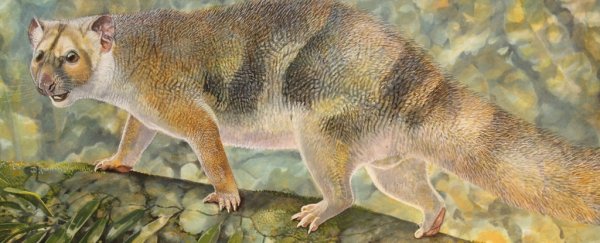Fossil remains have been discovered in the Riversleigh World Heritage Area of Queensland, Australia, and appear to belong to a new kind of tiny marsupial lion.
The long-extinct species was far more nimble than its bigger counterparts, with researchers suggesting that it would have travelled through the treetops of Australian rainforests, some 18 million years ago.
The team behind the discovery has named the species Microleo attenboroughi, for its small size, and in honour of everyone's hero, Sir David Attenborough.
"The species name honours Sir David Attenborough for his dedication and enthusiasm in promoting the natural history of the world and the paleontological treasures of the Riversleigh World Heritage Area in particular," the authors explain in the paper.
So what did this tiny lion look like? Based on the fossils, which include several teeth and skull fragments, the researchers think the new species would have been much smaller than its close relative - the marsupial lion, Thylacoleo carnifex.
"Microleo attenboroughi would have been more like the cute, but still feisty kitten of the family," said one of the team, Anna Gillespie Anna Gillespie, from the University of New South Wales' (UNSW).
"It was not lion-size or even bob-cat-size. Weighing only about 600 grams, it was more like a ringtail possum in size."
Check out the image below to see exactly how much small it was:
 UNSW
UNSW
So cute! Except that it definitely had incredibly sharp, knife-like premolar teeth, which would have ripped anything smaller then it to shreds.
"Microleo shared these northern Miocene rainforests with two larger species of marsupial lion, one cat-sized and the other dog-sized. Although it is possible they competed with one other, the size differences probably means they each specialised on a different size range of prey," said Gillespie.
"It's likely that Microleo scampered amongst the tree-tops, gobbling insects as well as small vertebrates such as lizards and birds while simultaneously trying to avoid becoming a prey item for its larger relatives."
The fossils were recovered from a limestone deposit, which the researchers think formed in a rainforest pool during the Miocene Epoch.
"The early Miocene of northern Australia, as documented by the thousands of fossils from Riversleigh, was a time of mild, very wet climatic conditions with mammal diversity more like that seen in Borneo than anywhere in Australia today," said one of the team, Suzanne Hand.
As well as this tiny marsupial lion, the team has discovered a giant platypus, a snail-eating marsupial, huge koalas, and the world's oldest (and very large) sperm - all in the same general area. Basically, Australia's current weird animals have nothing on those that were alive millions of years ago.
The team hopes to discover a more complete specimen of the micro-lion in the future to find out more about its life and habits.
"Tantalising questions about the rest of its skull and skeleton which could further clarify aspects of its lifestyle - such as whether it had an enlarged 'killing' thumb claw like its Pleistocene relative - must await discovery of more complete specimens," said one of the team, Mike Archer.
With so many amazing animals discovered at Riversleigh, we can't wait to see what they find next.
The research has been published in Palaeontologia Electronica and can be read for free online.
UNSW Science is a sponsor of ScienceAlert. Find out more about their world-leading research.
